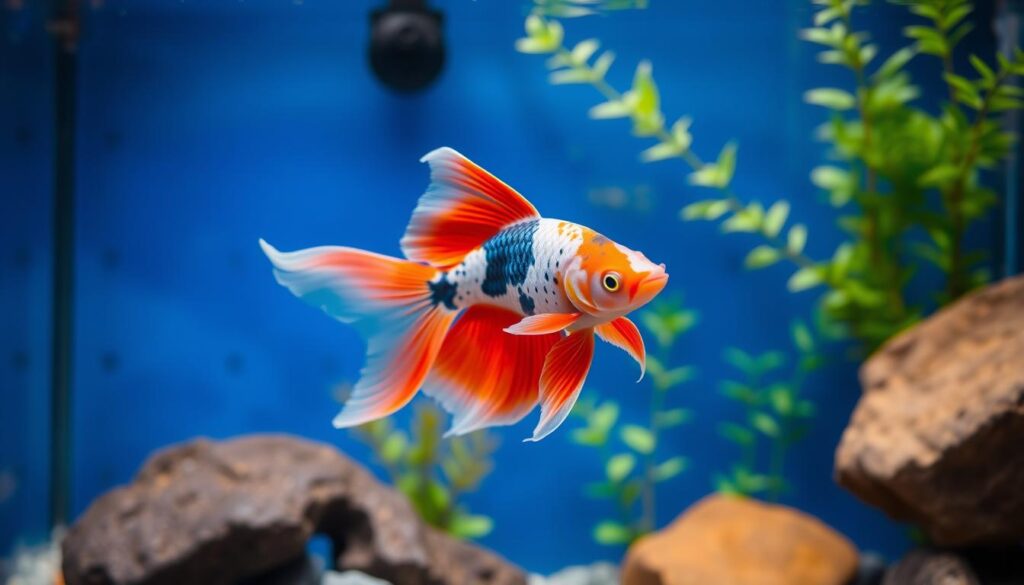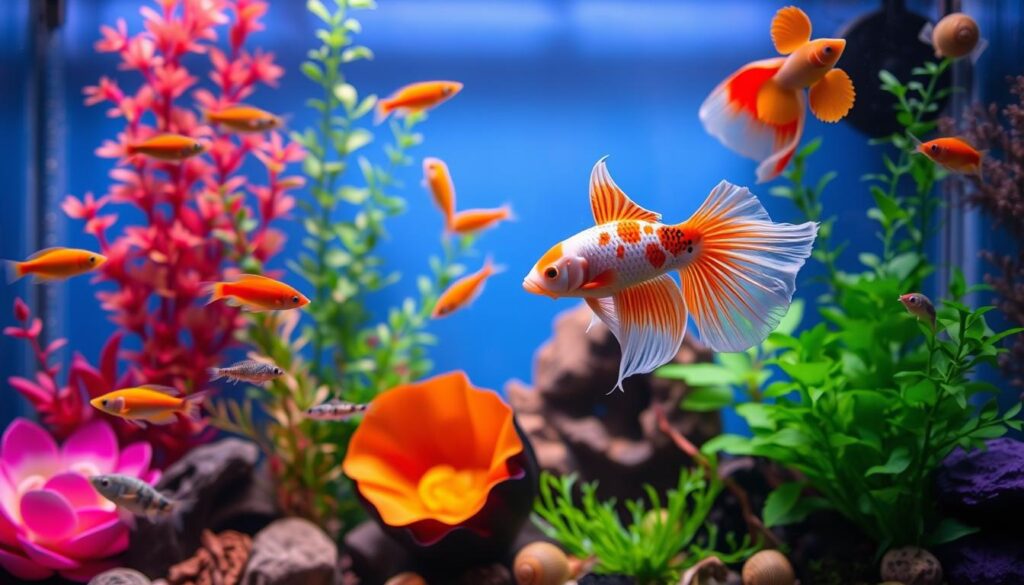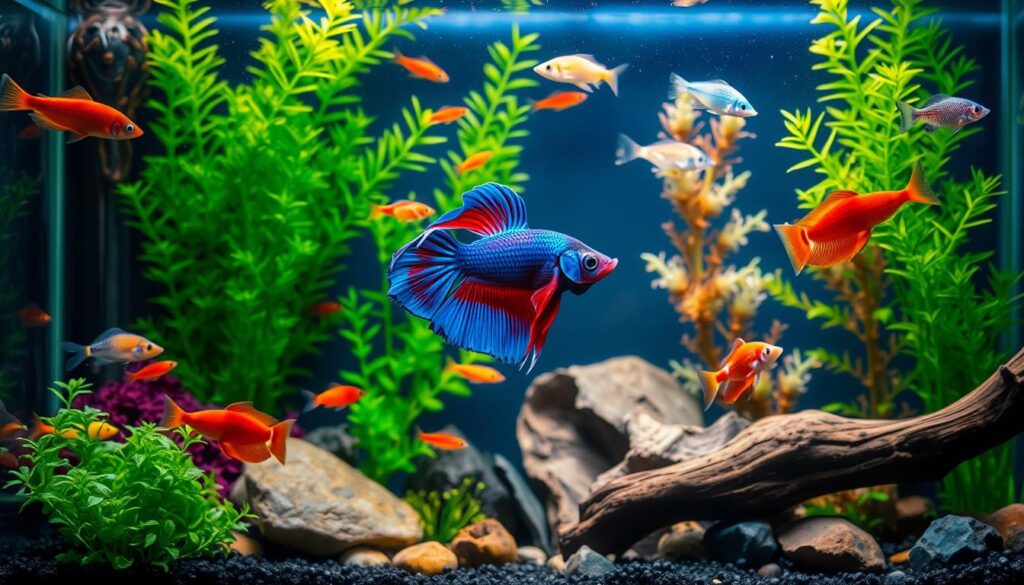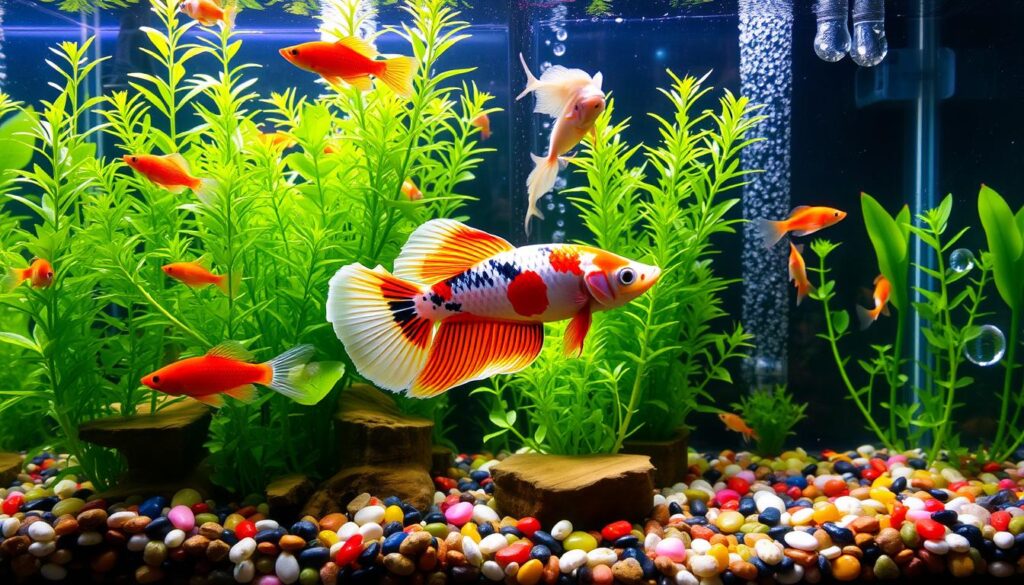Did you know betta fish can live well with others in a big tank? You need at least 5 gallons of water for them to get along. We’ll find the best friends for your koi betta fish, like harlequin rasboras and neon tetras.
Choosing the right friends for your koi betta is key. They need to be nice and need the same things. We’ll talk about the best size tank and water for a happy home for your fish and their friends.
Key Takeaways
- Koi betta fish can thrive in community tanks with the right tank mates.
- A minimum of 5 gallons of water is recommended for a harmonious environment.
- Compatible species, such as harlequin rasboras and neon tetras, make great koi betta fish tank mates.
- Providing the right environment, including optimal water parameters, is crucial for a thriving community tank.
- Koi betta fish tank mates, including other betta fish tank companions, require careful selection and introduction to the tank.
- Regular monitoring and maintenance are necessary to ensure a happy and healthy environment for your koi betta fish and their tank mates.
Understanding the Koi Betta Fish Personality
Choosing the right tank mates for betta fish is key. Betta fish are territorial and can be aggressive, but they can live with others. It’s important to know their behavior and pick the right tank mates.
When picking tank mates, think about their size, how they act, and how they swim. Small, peaceful fish like neon tetras or harlequin rasboras are good choices. But, stay away from fin-nipping fish or aggressive species. The right tank mates and a good environment can make your betta fish happy and show off their personality.
Click here to buy now: Aqueon Mini Bow 5-Gallon Tank – sleek, easy to clean, perfect for small spaces. Click here to buy now:
- Choose tank mates that are compatible with betta fish, such as neon tetras or cory catfish
- Provide a large enough tank with plenty of hiding places and visual barriers
- Maintain good water quality and stable water parameters
- Avoid overstocking the tank, as this can lead to stress and aggression
Follow these tips and understand betta fish behavior to create a great community tank. Research and pick the best tank mates for betta fish. This will make sure your tank is peaceful and healthy for all your fish.
| Tank Mate | Compatibility | Size |
|---|---|---|
| Neon Tetras | Compatible | 1-2 inches |
| Cory Catfish | Compatible | 1-3 inches |
| Harlequin Rasboras | Compatible | 1-2 inches |
Ideal Tank Size for Koi Betta
Creating a good home for our Koi betta fish is key. Tank size is very important for their happiness. A big tank helps keep the water calm and stops fights between fish. For one betta fish, a tank of at least 5 gallons is best.
When picking a tank, think about a few things:
- How many fish will live there
- The size of the fish
- How active the fish will be

Choosing the right tank size for betta fish helps our Koi betta and their friends. This makes sure they all live well together.
Also Read Best Diet for Female Koi Betta Fish: Optimal Care
Commonly Recommended Tank Mates
Choosing the right tank mates for Koi betta fish is important. Some good choices include neon tetras, harlequin rasboras, and corydoras catfish. Snails and shrimp are also good friends for them. Here’s what makes them great:
Click here to buy High-quality Betta Fish Food – boosts color, health & energy in every bite.
Some popular tank mates for Koi betta fish include:
- Neon tetras: schooling fish that thrive in groups of 6-10
- Harlequin rasboras: peaceful fish that prefer to be in schools of 6 or more
- Corydoras catfish: small catfish that are suitable for community tanks
It’s key to know what each fish needs. This helps keep the tank peaceful and happy. By picking the right tank mates for Koi betta fish, you can make a lively aquarium.

When adding new fish, do it slowly and watch them closely. This helps them adjust well and keeps your Koi betta happy.
| Tank Mate | Minimum Tank Size | Schooling Requirements |
|---|---|---|
| Neon Tetras | 10 gallons | 6-10 |
| Harlequin Rasboras | 10 gallons | 6 or more |
| Corydoras Catfish | 5 gallons | None |
What to Avoid: Aggressive Tank Mates
When you set up a betta fish community tank, picking the right tank mates is key. Stay away from aggressive fish to keep your tank peaceful. Fish with bright colors, long fins, or who act aggressively can stress your betta.
For a peaceful tank, pick tank mates that are calm and friendly. Cory Catfish, Harlequin Rasbora, and Ember Tetra are good choices. They get along well with betta fish and do well in a community tank with the right care.
It’s important to research and pick tank mates that fit well with your betta. By choosing peaceful fish and avoiding aggressive ones, you’ll create a happy home for your betta fish.

When picking tank mates for your betta fish community tank, remember a few things:
- Compatibility: Pick tank mates that match your betta in size, temperament, and water needs.
- Peaceful nature: Choose fish that are calm and won’t stress your betta.
- Proper care: Make sure you can take good care of all the fish in your tank.
| Tank Mate | Compatibility | Temperament |
|---|---|---|
| Cory Catfish | Compatible with betta fish | Peaceful |
| Harlequin Rasbora | Compatible with betta fish | Peaceful |
| Ember Tetra | Compatible with betta fish | Peaceful |
Also Read Male Koi Betta Fish: A Comprehensive Guide
Best Community Fish for Koi Betta
Choosing the right tank mates for your Koi betta is key. Look for peaceful, small, and non-competitive fish. White cloud mountain minnows and lemon tetras are great choices.
Adding fish slowly is important. It helps them get used to their new home and friends. This way, they won’t fight. Some good choices include:
- Neon tetras
- Harlequin rasboras
- Corydoras catfish
By picking the right fish and adding them slowly, you can make a happy aquarium. Make sure to learn about each fish’s needs for a healthy community.
| Fish Species | Size | Temperament |
|---|---|---|
| Neon Tetras | 1-2 inches | Peaceful |
| Harlequin Rasboras | 1-2 inches | Peaceful |
| Corydoras Catfish | 1-3 inches | Peaceful |
Role of Water Parameters in Tank Mates
Water parameters are key when picking tank mates for betta fish. It’s important to test and watch pH and temperature levels. Koi betta fish like water with a pH of 6.5 to 7.5 and a warm temperature of 80°F to 85°F.
Keeping an eye on water parameters helps prevent stress and sickness in fish. Regular water changes help keep the water just right. When adding new fish, think about their water needs too. Peaceful fish like Corydoras Catfish, Tetras, and Rasboras are good choices.
Here are some key water parameters to monitor:
- pH level: 6.5-7.5
- Temperature: 80°F-85°F
- Ammonia and nitrite levels: 0 ppm
- Nitrate level: below 20 ppm

By keeping water parameters right and picking the right tank mates, you can have a happy community tank. Always put your fish’s health first. If you’re not sure, ask for help.
| Water Parameter | Ideal Range |
|---|---|
| pH level | 6.5-7.5 |
| Temperature | 80°F-85°F |
| Ammonia and nitrite levels | 0 ppm |
| Nitrate level | below 20 ppm |
How to Introduce New Tank Mates
Adding new fish to your Koi betta’s home needs careful planning. Quarantine procedures help stop diseases from spreading. It’s best to have a separate tank for new fish before they meet your main tank’s residents.
A quarantine for betta fish lasts 2-4 weeks. Watch the new fish for sickness or stress. After the quarantine, you can introduce the new fish to your Koi betta.
Here are some tips for introducing new tank mates:
- Start with small, peaceful fish that are compatible with Koi betta fish.
- Introduce the new fish slowly, allowing them to become familiar with each other’s presence.
- Monitor the interactions between the fish, and be prepared to separate them if you notice any signs of aggression.
By following these steps and taking the time to properly introduce new tank mates, you can create a harmonious and thriving aquarium environment for your Koi betta fish.
Rescuing Koi Bettas from Aggression
We know that aggression in fish is a big problem. It’s key to spot the signs early to save your Koi betta. When rescuing Koi betta from aggression, you must act fast. This stops more stress and harm to your fish.
Signs of aggression include fin nipping, chasing, and claiming territory. To fix these problems, conflict resolution in fish needs careful steps. This includes separating the aggressive fish, adding hiding places, and making sure the tank is good for all fish.
Also Read Betta Fish Breeding Tips: Unlock the Secrets of Koi Bettas
Signs of Aggression Among Fish
- Fin nipping
- Chasing
- Territorial behavior
Best Practices for Conflict Resolution
To solve conflicts, find out why the aggression started and fix it. This might mean separating the aggressive fish, adding hiding spots, or changing the tank’s water to reduce stress.
When to Separate Fish
It’s sometimes needed to separate fish to stop more aggression. If you see signs like fin nipping, chasing, or territorial behavior, separate them right away. Give each fish a safe place to live and grow.
| Signs of Aggression | Actions to Take |
|---|---|
| Fin nipping, chasing | Separate the aggressive fish, add hiding spots |
| Territorial behavior | Adjust tank layout, provide more space |
Enhancing the Tank with Plants and Decorations
We think adding live plants and decorations is key for a great home for koi betta fish. Plants make the tank look nice and keep the water clean. They also help reduce stress for our fish. Good plants for betta tanks include Java fern, Anubias, and Cryptocoryne. These plants are easy to care for and do well in little light.
When picking plants, we look at what light they need, how to feed them, and if they get along with our fish. For example, Amazon frogbit grows fast and helps clean the water. Vallisneria is great for the back of the tank because it grows fast and gives our fish places to hide.
Decorations like rocks, driftwood, and treasure chests add fun spots for our fish to hide. They also make the tank look interesting. By adding different decorations and plants, we make a fun place for our betta fish to play and live.
| Plant | Lighting Requirements | Fertilization Needs |
|---|---|---|
| Java Fern | Low | Comprehensive liquid fertilizers |
| Anubias | Low | Comprehensive liquid fertilizers |
| Cryptocoryne | Low to High | Nutrient-rich substrates |
By choosing the right plants and decorations, we make a great home for our koi betta fish. Whether you’re new to fish keeping or have been doing it for a while, we hope this helps make your tank better. And it makes your betta fish happy.
Nutrition for Koi Betta and Their Mates
It’s key to give your Koi betta fish and tank mates a balanced diet. Nutrition is very important for their health. A well-fed Koi betta fish will do better in its home and avoid health problems.
For nutrition for Koi betta, pick high-quality food that fits their needs. Koi betta fish love to eat meaty foods. A good feeding schedule for betta fish includes pellets, flakes, freeze-dried, and live foods.
Importance of a Balanced Diet
A balanced diet for Koi betta fish should have lots of protein. Good foods include:
- NorthFin Betta Bits: 45% protein
- New Life Spectrum Betta Formula: 37% protein
- Ocean Nutrition Betta Pellets: 36% protein
Koi betta fish have small stomachs. They need small meals often. An adult betta fish should eat about 1.8 grams of food each day.
Feeding Schedule Tips
Make sure your Koi betta fish get food regularly. You can feed them one big portion a day or two small portions. Soaking freeze-dried foods in tank water helps prevent stomach problems.
By giving a balanced diet and a regular feeding schedule for betta fish, your Koi betta fish will stay healthy. Choose high-quality foods and ask a pet care expert if you have questions about nutrition for Koi betta.
| Food Type | Protein Content |
|---|---|
| NorthFin Betta Bits | 45% |
| New Life Spectrum Betta Formula | 37% |
| Ocean Nutrition Betta Pellets | 36% |
Conclusion: Building a Happy Koi Betta Community
We’ve learned a lot about Koi betta fish and their friends. Now, let’s remember what makes a happy Koi betta home.
Recap of Key Considerations
Finding the right tank mates for Koi bettas is very important. They do best with calm, friendly fish. Knowing their personality helps us choose the best friends for them.
Encouraging a Healthy Environment
Keeping a good Koi betta community means more than just friends. We need to watch the water, add hiding spots, and feed them right. This makes a happy place for all.
Final Thoughts on Tank Mates
Now you know how to make a happy Koi betta community. Follow what we said, and you’ll have a beautiful tank. Enjoy watching your fish!

